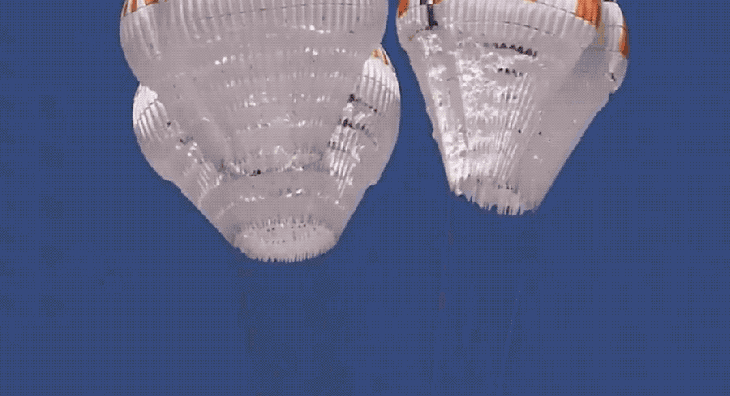SpaceX has managed to run 13 successful parachute tests in a row of the third major revision of the parachute system it’s planning to use for its Crew Dragon spacecraft. The most recent test, which SpaceX shared a shorted edited video clip of on Twitter, involved using the system with one of the parachutes intentionally not deploying, to prove that it can land the crew craft safely even in case of a partial failure.
This is a big step for SpaceX’s plan to launch NASA astronauts aboard Crew Dragon. Last month, NASA Administrator Jim Bridenstine visited SpaceX headquarters in Hawthorne, California, where he and SpaceX CEO Elon Musk held a press conference to discuss their progress on the commercial crew program. At that event, Musk said that he felt SpaceX was aiming to do “at least” 10 successful tests of its revised ‘Mark 3’ parachute system in a row before any astronauts fly with the system in use.
“We certainly want to get […] at least on the order of 10 successful tests in a row before, before launching astronauts,” Musk said at the time. “So that seems like where the the behavior of the parachutes is consistent, is across 10 successful tests.”
At the time, Musk added that they were anticipating get to at least 10 successful test prior to the end of the year, so managing 13 definitely fits with that schedule, and in fact seems to be a rare occasion where SpaceX is actually ahead of the often optimistic timelines that Musk sets as targets.
This third generation of parachute being used for Crew Dragon uses Zylon in place of nylon, which is a polymer material originally developed by SRI and that provides the lines used in the parachute around three times the strength of nylon. SpaceX also updated the stitching pattern to optimize the load balance on the new parachutes.
Next up for SpaceX is a launch aboard test that should happen as early as this coming week. SpaceX’s test will be a ground-baed test filing of the Crew Dragon’s abort engines, which is set to happen as early as Wednesday. After that, it’s still hoping to get an in-flight abort test done before year’ send, which will show how the Crew Dragon can jettison from a Falcon 9 rocket after lift-off in case of emergency.
Both NASA and SpaceX have expressed optimism about getting an actual crewed flight off the ground early next year, provided everything else in terms of testing requirements goes smoothly between now and then.
